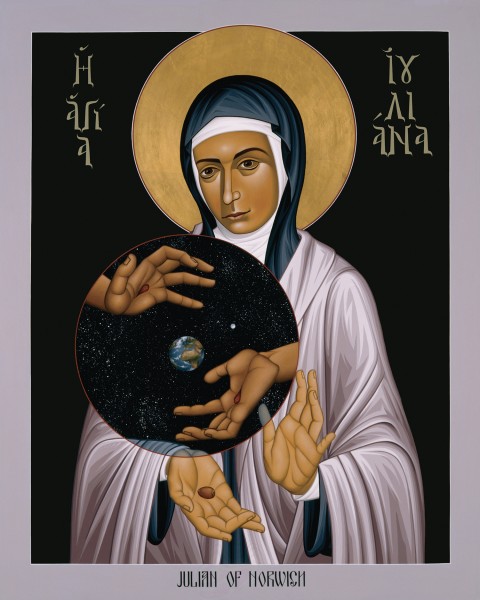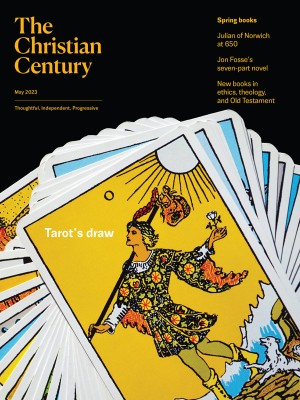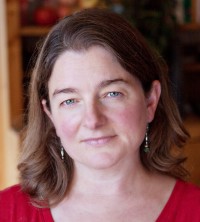Julian the theologian
We ignored her for hundreds of years. Then we reduced her to a slogan.

Julian of Norwich in “Dame Julian’s Hazelnut,“ an icon by Brother Robert Lentz, OFM (© Br. Robert Lentz, OFM. Courtesy of Trinity Stores / trinitystores.com)
It’s rough to be a theologian of incredible insight and depth who is essentially forgotten or ignored for the first 550 years of your existence and then turned into a cliché for the last 100. Welcome to the 650th anniversary of the visions of Julian of Norwich, the woman who lived in an anchor-hold at St. Julian’s on the east coast of England and spent the second half of her long life writing two versions of the same book: A Revelation of Divine Love. Since her writings were rediscovered for a broader audience, she’s often been seen more as a spiritual curiosity than as a theologian whose thought deeply influences the tradition. We cite her in search of personal spirituality and often use her for spiritual comfort, but less often do we allow her ideas and her unique approach to the spiritual questions of her day to penetrate our theological understanding.
The outlines of Julian’s life are all that anyone really knows about her. She lived through two devastating plagues—one that killed 75 percent of the population of Norwich when she was a child and a second that killed 75 percent of the children there when she was a young woman of childbearing age. Eventually she took up residence in an anchor-hold at what we might call an inner-city church, surrounded by stockyards and a slaughterhouse and a very smelly tanner, not far from the charity hospital where the most desperate cases were cared for by nuns and beguines. She lived there for the rest of her life.
Read our latest issue or browse back issues.
She gained a reputation for being a person of deep prayer and a good person to take your ordinary pains and struggles to. Her writings and one first-person account reveal her to be a woman of strong practical wisdom and an earthy sensibility, even when she is quoting Augustine or Jerome. We know people went to the anchor-hold to seek her advice and her spiritual care. In the anchor-hold, she was also writing a book about an experience from a time in her life when she had wanted desperately to die. She had a series of “showings”—as she later called them, searching for an English word that would express what she had seen—in which Christ revealed to her the depth of God’s love for humanity. She tried to pass on what she had seen through two versions of the same book. She was, as far as we know, the first woman to write a book in English.
She wrote this book during a time when it was expressly forbidden by the archbishop of Canterbury for any woman to teach and for anyone to write a book of spiritual teaching in English. Not far from her anchor-hold, where we assume Julian put pen to calfskin, people were being burned for doing the same. At some point, these books were passed out of the anchor-hold. They somehow survived the reign of Henry VIII, when the regime was burning books in order to make weapons out of the metal clasps that held them together. They were rediscovered across the sea in France, where a group of English-speaking nuns used them to undertake a curriculum in prayer.
In 1670 Serenus Cressy, royal chaplain in the court of Charles II, produced a printed edition of A Revelation. Editors Nicholas Watson and Jacqueline Jenkins describe this edition as “personalized.” Its introduction is responsible for codifying the notion of Julian as not a thinker and interpreter of the Christian tradition but a devout curiosity and a teacher of personal spirituality—an idea that still tempts us today.
Julian remained unknown outside English-speaking monasteries until spirituality movements of the late 19th and early 20th centuries, when non-Catholics were looking for sources and discovered Julian among them. Evelyn Underhill included Julian in her groundbreaking 1911 book Mysticism: A Study in the Nature and Development of Man’s Spiritual Consciousness. From there the tradition grew, with Julian’s writings being passed from hand to hand by people in search of spiritual wisdom, practical theology, and the practice of prayer.
The Julian we all know well by now is a spiritual counselor for the deeply worried. Most of us have gone through periods or moments in our lives when we have needed her words, “All will be well, and all will be well, and all manner of all thing will be well,” even if we’ve said them without fully believing them. Or maybe we have said them to friends going through hard times, hoping that they may imbibe the words better than we’ve been able to. Julian’s thought has often been reduced to one resonant image: the hazelnut as a symbol of God’s love. Julian is also, to many of us, the purveyor of that strange teaching that there is no such thing as sin. That seems utterly impossible to us, as we look in ourselves and all around us and see both sin and its evidence. It makes us think that she must’ve been naive in some way, locked away in that anchorhold, someone who refused to see the world as it really is, as we know it to be.
But what about the lesser-known Julian? What ideas was she grappling with that didn’t end up lending themselves to bookmarks and sound bites? Over the past 650 years, few have been able to piece together the many Julians—theologian, spiritual teacher, practical guide, soother of souls—but this is precisely the Julian we might most need to meet today, at a place where spirit needs body, ideas need practical wisdom, and high theology needs the everyday.
To explore this, we might start with Julian as a theologian of the Trinity. In the first showing, while the blood is trickling down from the crown of thorns on Jesus’ face, Julian looks at this image and sees the Trinity:
And in the same showing, suddenly the Trinity filled my heart most of joy. And so I understood it shall be in heaven without end, to all that shall come there. For the Trinity is God, God is the Trinity. The Trinity is our maker, the Trinity is our keeper, the Trinity is our everlasting lover, the Trinity is our endless joy and our bliss, for where Jesus appears, the blessed Trinity is understood, as to my sight.
Wherever Jesus is, she says, there we also find the Father and the Spirit. But this is not something to be understood on one level only. It’s not an abstract idea. The Trinity is first felt—as joy, as bliss—and then understood.
We usually have it the other way around—if we ever get to the feeling part at all. But for Julian, the mystery of the Trinity is a physical, emotional, intellectual, and spiritual perception. The Trinity is more of an experience to Julian than an idea. Why? How? Because God is fundamentally and inextricably a relation of love. When you perceive any one person of the Trinity, you experience them all—if you have perceived the presence of love. This is how we know that the cross is love. Because there, mysteriously, is the relation of the Trinity.
Not only is God triune, but our souls are as well: we are made in the image of God, gifted with incarnation, and “enspirited.” This means that we too are a relation of love. Wherever our bodies are present, there also is our spirit and our fundamental goodness—each of these three loving each other as the three of the Trinity love each other, and each “oned” to the other as God in the Trinity is oned. Julian believed profoundly that our very incarnate being was a path to God, that through the body—not in denial or hatred of it—we would find our way.
This lays out a trinitarian spiritual path for us. “Our whole life is in three,” she writes. “There is our being, our increasing, and our fulfilling.” The first is our very nature, the second is what happens to us through God’s compassion, and the third through God’s grace. Wherever we look in our lives, we can see God acting in and through us using this trinitarian method.
With the trinitarian God, our trinitarian souls participate in the work of “oneing.” Because of the dynamic nature of God and of ourselves, oneing is a verb, not a given state. Oneing, a word which Julian invented to describe this action, is the process by which, via the Trinity, “all things were made and all things will be made well.” It’s a constant process of growth and development, rooted in our nature as made in the image of God, drawn out by the work of compassion in our lives and made real by the work of grace, in a process of “endless loving.”
This not only speaks to the high and abstract ideas of who God is in the Christian tradition but also attends to what Julian calls the “lowly things”: the ordinary grit of our everyday lives, the slow process of the development of our character, the desert of prayer, the ways we encounter our neighbors, our acts of service. Julian’s theology speaks simultaneously to our heads, our hearts, and our bodies, just as the Trinity spoke to her from the vision of the cross.
Another well-known but little-understood aspect of Julian’s theology is the idea that God is our mother. Since trinitarian theology is so important to Julian, it is hard for us to make her idea of God as mother fit. We’ve already got the Godhead well peopled. But in Julian’s theology, all aspects of the Trinity involve mothering and motherhood. We have multiple mothers.
To begin, Jesus’ mother is our mother because she bore the incarnate Word through whom we have our own incarnation. But Jesus is also Mary’s mother, because she has her being in Jesus and through Jesus, just as he has his being in her and through her. God the Father is also our mother, and the entire Trinity is our mother. In other words, the motherhood of God is essential, in everything, through everything. “We are in God,” Julian writes, “and God, whom we do not see, is in us.”
In order to comprehend this, we have to get out of our ordinary binary thinking and our need for binary pronouns. God is both mother and father. Jesus is brother and mother and lover. God is our mother through being, the “matrix in which all exists,” as Mary Earle writes. In this sense, God as mother is not simply metaphorical, as it often is in the Christian tradition and as it may have been for many of Julian’s contemporaries. Julian often urges her readers to consider that Jesus is truly our mother, in a way that is perhaps beyond metaphor. And that God is truly our mother, “just as God is truly our father.”
God is our mother through service, through the nurturing care that Julian calls “nearest, readiest, surest.” She uses many metaphors for this nurturing soul-care of God for us: clothing, knitting, housing, holding, wrapping, feeding, cleaning, laboring, feasting. In her understanding, the cross itself is a form of labor that gives birth to all creation. Jesus is our mother because as the incarnate Word he gave birth to us—and because he is closest to our ordinary needs and tends to them in acts of mothering. He is our mother because for love he labors on our behalf.
As we saw in Julian’s trinitarian theology, being and doing are united in the motherhood of God. Through God’s mothering, we are drawn toward our own essential nature. The cross isn’t a onetime event that gave birth to us. Like oneing, it is a process that is ever ongoing. Oneing is itself a maternal action—one that, as Julian tells us again and again, is truly a delight for God.
To make sense of all of this, we have to “taste non-dualism,” as Matthew Fox puts it. Nouns become verbs, many become singular, we become God, and God becomes us. Joy becomes suffering; suffering becomes joy.
This perhaps then allows us to enter into Julian’s insistence that there is no such thing as sin. “I believe,” she writes, “that [sin] has no sort of substance nor portion of being, nor could it be recognized were it not for the suffering it causes.” Substance is Julian’s word for the goodness which is inherent in us. Everything that God creates is good and shares in the divine nature. Therefore, it has substance. Because sin was not created, it can have no substance. That doesn’t mean that we don’t suffer. It doesn’t mean that we don’t experience the effects of sin. But we are encouraged to understand sin’s transience and not objectify it.
For Julian sin is like the stuff that goes into the compost. It isn’t yet what it will be. For the moment, it appears as slime. But through God’s inner, mysterious working, it will become soil. And until sin becomes soil, God isn’t finished with it.
This isn’t a conclusion that Julian comes to easily. This is not a denial of death or a denial of pain. This is a hard-won conclusion based on deep engagement with her own suffering and the suffering of those around her. An anchorite is not a person who hides from the world but rather one who takes on the spiritual struggle of a parish and prays for the people of that parish. All of Julian’s writing is best understood as theodicy: an anguished, deeply personal struggle to understand the nature of the suffering that she experienced and saw around her, in her plague- and violence-ridden society.
Each of Julian’s attempts to tell the story of her showings is a story of a process, a story of spiritual development and growth. We see Julian grow from a naive young woman who wanted “three wounds,” to a desperate young woman who wanted to die, to a seeker steeped in mystery, to a deep practitioner and spiritual guide whose work continues to mystify and remind, comfort and disturb. Even though most of us have a thoroughly codified understanding of Julian, I don’t think she’d mind if we understand that only love matters. In the end, she is adamant: it is all love.
I find the final words of the long text of A Revelation both profound and funny, gently self-deprecating and human. Julian writes that after 15 years of struggling with the meaning of the showings, she still “oftentimes wondered what was our Lord’s meaning.” An almost exasperated interlocutor, whom Julian calls her “ghostly understanding,” answers her. “What? You wish to know the Lord’s meaning in this thing? Know it well, love was his meaning. Who showed it to you? Love. What did he show you? Love. Why did he show it to you? For love.” It seems that 650 years later, we are still trying to perceive this ghostly understanding and hear Julian’s message of absolute divine love.







